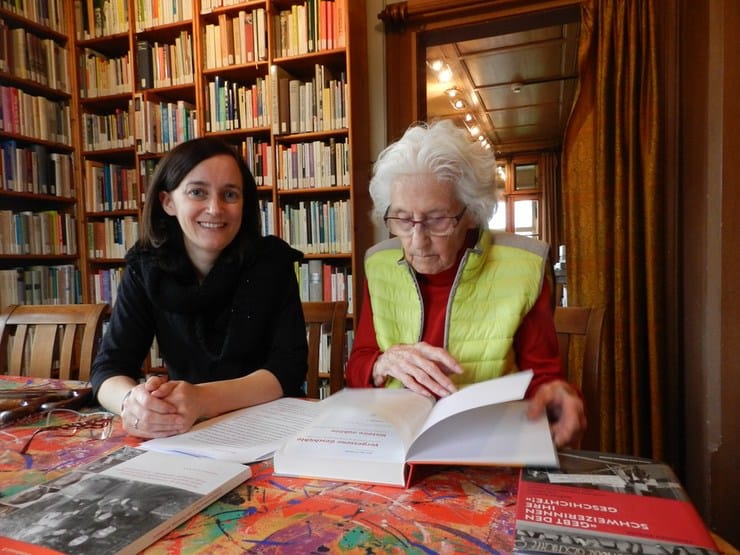Working mothers in Switzerland – something has to give

Switzerland manages to successfully project two flattering but contradictory images side-by-side. On the one hand, it is a rural mountain idyll populated by wholesome country folk and dotted with chalets, ski resorts and pretty medieval towns. On the other side, it is a sophisticated economic hub powered by a productive and innovative workforce.
It is a delicate balance if you can spend your working hours in business Switzerland and your free time in rural Switzerland. But for women, it is certainly not easy if you are expected to raise a family in the traditional model while facing all the challenges of the modern workplace. Something has to give.
The majority of mothers in Switzerland try to tick both boxes by working part-time. Although this choice may appear to offer the best of both worlds, combined with other obstacles, it often spells the end of any career progress.
The 2017 Schilling Report on gender balance in Swiss companies shows how dramatically women disappear from the so-called leaky pipeline that leads to top management. Women in the companies surveyed made up 37 per cent of the workforce. At the middle management level, this dropped to 21 per cent, senior management 14 per cent, with only 9 per cent of the board or leading positions occupied by women.
At 1.5 children per woman, the fertility rate in Switzerland is low, though pretty close to the EU average. Lack of affordable childcare is often singled out as an obstacle to having children in Switzerland. While it’s true there are not enough day-care places to meet the demand; daycare is not the preferred choice for many Swiss parents.
Handing your children over to the care of strangers – “fremdgeben” – still has a stigma attached to it in Swiss society. It is not that long ago that single parents and low-income families were forced to hand over their children into an inadequate care system.
While researching her book, The Naked Swiss: A Nation Behind 10 Myths, Clare O’Dea met Marthe Gosteli (1917-2017), one of the last surviving Swiss suffragettes. Many women I know who wanted to increase their working hours were only prepared to do so if the grandparents could step in or their partner could reduce his hours to cover. Currently, just 12 per cent of fathers of children under six work part-time. When children attend daycare, mothers are quick to emphasise that their child is only in there a certain number of days or half-days per week. It is as if anything that falls shorts of the ideal of family care at home is problematic. Today, around a quarter of mothers of children under six are not in paid employment.
Even when children start school, there are still large parts of the country where there is no system in place to cover the childcare gap at lunchtime.
It is a sweet sight in Swiss towns and villages at around 11.30 in the morning when the children leave school. You see them getting onto the public buses or walking home, the smallest ones wearing their regulation reflective triangles – another day in paradise. School closes for the next two hours, and the children can eat a hot meal at home and relax before going out again, replenished, for the second half of their school day from 1.30pm to 3.30pm, in most cases.
What you don’t see are the (mostly) women in the kitchens, frantically putting away shopping while chopping and stirring, doing their bit to live up to the Swiss ideal of the family eating together in the middle of the day.
Many schools and communes have yet to introduce any infrastructure for this childcare gap, and they are under no obligation to do so. But the approach is changing, especially in urban areas. Beginning in 2016, Zurich converted six schools to the full-day timetable with a hot meal provided on site, intending to make this model compulsory from 2018.
A study by Basel city’s education department found that one in four primary school children receive a meal and supervision during the lunch-time break, the availability of places having increased fourfold over ten years.
Is it any wonder the vast majority of working mothers of school-age children work part-time? The apron strings are so tight in Switzerland that the overwhelming majority of women with children under 25 work part-time at most. Fewer than one in five mothers living with a partner whose children are between 15 and 24 work full-time (18.8% to be exact), 17% don’t have a paid job and a quarter work 50% or less.
For parents who have genuinely chosen to stay at home to be the primary carers of their children, Switzerland provides something of a haven. Their presence at home is accepted, rather than questioned as it might be in other advanced economies, and is in no small extent indispensable. Many parents cherish the fact that their children can come home for lunch and children who enjoy the respite and home cooking too.
But this model carries the risk of creating a gilded cage where stay-at-home mothers can’t see a way out. Their children may be away for 20 or 30 hours a week but the hours are broken up in such a way that it becomes devilishly complicated to think of taking on another commitment, paid or not.
Something needs to be done to make it easier for mothers to “lean in”. It doesn’t help that job applicants are required to include their marital status and the dates of birth of their children on their CV. This information is much more likely to work against female job seekers.
The story of women in Switzerland in living memory is a story of enormous change and progress. Women got the right to vote in federal elections and referendums in 1971. Without family support, a woman in those days would find it practically impossible to keep a child born “out of wedlock”. Until 1988, women lost control of their assets on marriage.
Until 1992, a woman lost her citizenship on marrying a foreigner and could be raped by her husband without having recourse to the law. Swiss women saw their first female president in 1999, Ruth Dreifuss.
Mothers had to wait until 2005 to receive a legal guarantee of maternity pay. Equal pay was enshrined in the Constitution in 1980, and if not fully achieved, is at least enforceable. Until the 1990s, military service secured huge networking advantages for men; officer rank was virtually a must for anyone with managerial ambitions. But even this seemingly impermeable rock of privilege has dissolved in the multicultural and open economy of today.
This steady morphing of women into the legal equivalent of male Swiss citizens has been hard won and is to be celebrated. The old separation between Männersache (men’s affairs) and Frauensache (women’s affairs) has worn thin, making it possible for women and men to expand their horizons in more fulfilling ways.
The unfinished business is this thorny issue of reconciling work and family life. The battle starts on the home front. Once the arrival of children into the picture is seen as solely the mother’s logistical problem, it is very difficult to change that unwritten rule, and the burden will never truly be shared. Maybe employers would be more inclined to listen if men added their voices to the call for family friendly policies.
The Swiss are innovative in so many other ways. It is high time that innovative spirit was used to create inspiring solutions to gender inequality and to finally solve the conundrum about how best to reconcile the needs of the country’s families and its economy.
Submitted by Clare O’Dea
More from International School Parent
Find more articles like this here: www.internationalschoolparent.com/articles/
Want to write for us? If so, you can submit an article here: www.internationalschoolparent.submittable.com
